Hamster Nest Dash Snow Art in the Late 1990s Early 2000s
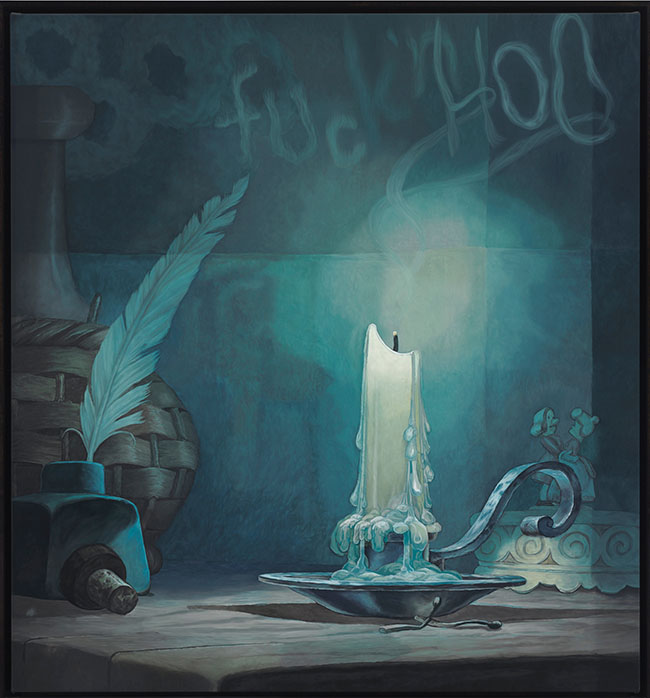
Dan Colen, 2006, Boo Fuck'northward Hoo, oil on canvas, 68 10 62¾ in. (172.7 x 159.3 cm.)
Will Success last for the zero-to-$60,000 plus auction stars?
Nov in New YorK, the Philips' evening sale of contemporary fine art began with a bang when a large oil on canvass past Lucien Smith titled Hobbes, The Pelting Homo, and My Friend Barney/Under the Sycamore Tree, 2011, came up for consideration. The dealer-collector Alberto Mugrabi, seated in the front row, outmaneuvered multiple phone bidders to win the painting—described in the catalogue as "an important lodestar in the artist's artful, besides equally psychological, constellation"—for $389,000, more than double its $150,000 high estimate. It was Lot I of the sale, and as well the first work by Smith, 25, to appear at auction.
To some observers, the sale—which was bookended by a $293,000 consequence for a scribbled painting by 28-year-sometime Oscar Murillo, who last year signed with mega dealer David Zwirner-represented the apogee of a marketplace run amok. The Smith and Murillo sales are just two examples of a much-remarked surge in sale block prices for immature artists, predominantly male person, who favor a practice of big-scale abstraction.
The parlor game of determining which immature artist's star is rising or falling has disturbed the frail ecosystem of the art marketplace, with a six-effigy auction result able to outrun a curatorial or critical imprimatur. "Let's not refer to this success as early," cautions Bob Nickas, an independent curator and writer who has been active in organizing group shows of young talent, "but in terms of what it really is: premature."
Seismic shifts in both price and supply likewise affect the ability of ardent collectors to continue to acquire works after their initial showings in the main marketplace. Co-ordinate to New York collector Frank Moore, who over the years has focused on rising talents from Richard Prince to Wade Guyton, the current premium for ubiquitous youngsters has a chilling consequence on patronage. "In the past, y'all were able to follow the artist sequence to sequence. At present, when they get spun around, instead of being rewarded for beingness there early in the career of the creative person, you become punished." He rationalizes, "I don't listen spending a lot of coin for a Christopher Wool if information technology becomes available because I realize that'due south the fair marketplace value, merely for other cases information technology is an unfair marketplace value—unfair for the artist and unfair for the collector."
Far from spurning the speedy commercialization of their work, however, today's immature artists are apt to participate in it. "In the 1980s," says Francesco Bonami, the peripatetic guest curator and artistic manager of Turin's Fondazione Sandretto Re Rebaudengo, "the young hot artists were too function of the curators' attention. Museums wanted to practise shows. Today it's a little scrap the opposite. Information technology'due south kind of a dangerous departure," he adds. "Back then, [artists had] an intention to be part of the entire organisation. Now they're but part of the market."
The lines are further blurred past the present-24-hour interval capacity of many dealers to mount institutional-quality presentations, while leery museum curators shy abroad from playing into an overheated marketplace.
Dealer Steve Turner, of Steve Turner Gimmicky in Los Angeles, represents recent darling Parker Ito, a 2010 BFA from the California Higher of the Arts. In an illustration of the wheel's electric current breakneck speed, when Turner featured Ito in the summertime group show "Wet Paint 4" in 2012, paintings from the artist'southward "The Agony and the Ecstasy" serial were priced at $ane,800 apiece. They have since traded hands at auction for more $55,000, and this summer Ito was tipped by the investment website ArtRank for liquidation.
"I've visited artists," Turner says, "where they take 50 works stacked upward in their studio because they're going out to a [non-dealer] middleman who will source them out to certain other people and create a kind of fake market. I'k not involved in it, but I come across it. This is rampant."
The phenomenon raises questions about whether whatever of these young contenders can thrive beyond an 18-month-long auction spurt. Close behind that query are more difficult questions about manipulation in that boisterous part of the market—or in one-time-fashioned financial parlance, how much of that activeness is produced by "painting the record," creating an bogus price for a "security." At that place have ever been buyers who seek to game the system by cornering an artist's market, buying low and selling high, but some say the electric current rewards may be encouraging irresponsible, if non outright illegal, behavior. "It would be securities fraud on Wall Street," says a New York–based fine art adviser who requested anonymity. "Any time an artist is represented by multiple dealers and they collaborate on supporting the artist's market place, even at the $100,000 level, you can debate that's a syndicate."
Some point fingers, fifty-fifty admiringly, at a small cabal of dealer-collectors who ever seem to be in the picture when a new artist's market takes off. The Mugrabi family would surely be at the acme of that list, having invested in now-established artists like Urs Fischer. Alberto Mugrabi explains his approach thus: "When I buy them at auction, it'due south because I've already bought a lot of them privately, and then I tin can make a statement paying $300,000 for a Lucien Smith. Merely I would never do that to start my buying with i of these young artists."
Mugrabi the potential for long-term disruption, however. "Will it hurt the marketplace? Absolutely not. When one goes out, a new i comes in." He goes on, "There are a lot of elements that determine whether an artist volition persevere or not. It's all tricky. Today they can exist kings of the globe—and tomorrow? They disappear" Just time will tell whether or non these immature painters and sculptors tin can maintain their early momentum. Following is an examination of the market arcs for four such artists.
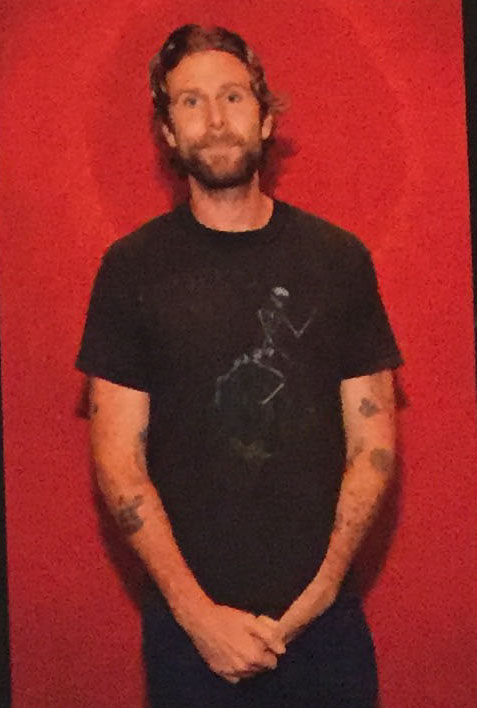
DAN COLEN
Forged in the crucible of the Rhode Island School of Design painting section in the belatedly 1990's. Colen, 35, son of a sculptor and a grandson of a Brooklyn antiques dealer, has been on the art market radar longer than some of today'due south flavors of the moment. Having come prominence in the early on woos as part of the downtown crew that included the late Dash Snow—the duo'southward infamous "hamster nest" installation was shown at Deitch Projects in 2007—Colen has since vaulted into the big fourth dimension.
In the past decade, the 2006 Whitney Biennial alum was featured in several headline-garnering shows, such a the Charles Saatchi–selected " The states Today" exhibition at t Royal Academy in London in 2006 and the Jeff Koons-curated "Pare Fruit" show culled from the Dakis Joannou collection at the New Museum in zom. Colen'south showtime retrospective, "Help!," opened at the Brant Foundation Art Report Eye in Greenwich, Connecticut, this by May, and September saw his eighth show at Gagosian Gallery, which featured nine paintings from his "Miracle" series, large-scale abstractions that bring to mind color-charged, ethereal works by second-generation Ab-Exers like Kenneth Noland and Paul Jenkins. All were sold before the opening.
Colen has also accomplished an enviable rails record at auction. The campaign began in May zoo8 at a contemporary art day auction at Phillips de Pury in New York, a spawning ground for new talent. There, the graffiti-inspired Holy War, 2.005-06, a collaboration with Nate Lowman, an oil on a silkscreen ink print on sail, claimed its low guess of $15,000.
A year later, at a May 2009 evening auction at Sotheby's New York, 4 bidders chased Untitled (Blow Me), an oil on canvas from 2.005 featuring a snuffed-outcandle inspired by an animation cel from Walt Disney's Fantasia, to a tape $386,500 (est. $100-150,000). It was only the fifth work by Colen to appear on the cake.
Of Colen's approximately xc outings at auction, peppered with examples from his chewing-gum and false-bird-shit paintings, few buy-ins take marred his ratings, and 34 works have hurdled the $100,000 mark later premium. Two works have sold for more than $i million, led past Boo Fuck'n Hoo, 2006, another of the Disney-inspired candle paintings; it sold at the nail-success, heavily guaranteed "If I Live I'll Run into You lot Tuesday" auction at Christie'southward New York in May tor $iii,077,000 (est. $2-iii million). It was understood to take been consigned by a major Italian collection and was originally acquired from Peres Projects, the Los Angeles/ Berlin enterprise run past Javier Peres, who specializes in launching fresh talent. The dealer, who currently represents budding fine art stars Alex State of israel and David Ostrowski, recalls that he sold the Colen painting in 1006 for $22,500.
Still, with all his market muscle, Colen is represented in merely two museum collections, the Whitney Museum of American Art and the Astrup Fearnley Museum of Modern Art in Oslo. "Upward to now," says Peres, "it was just accepted that museums have the outset and last word" on an artist'due south reputation. "Now at that place'south a shift to collectors who put their money where their oral cavity is and who decide who'southward in and who'southward out. The big collectors think he's in."
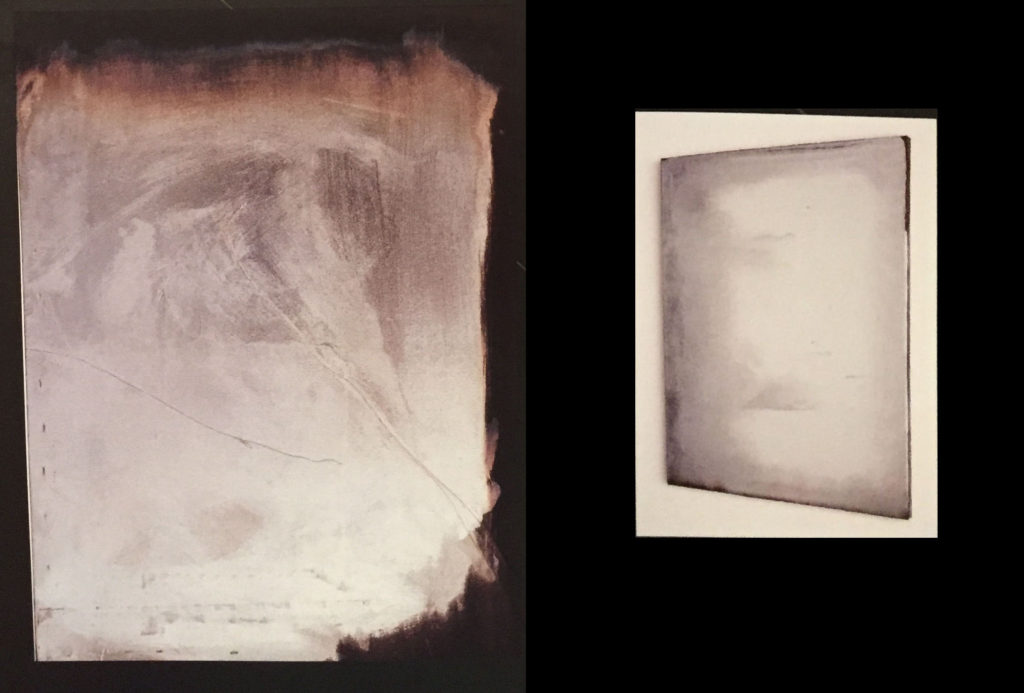
Two untitled silver paintings from 2009 by Jacob Kassay. The one on the right sold for $86,000 at Phillips in November 2010; the i on the left fethced $290,500 at the aforementioned house in 2011.
JACOB KASSAY
Kassay is a graduate of the State University of New York at Buffalo, home of the storied HaLLWalls gallery where Pictures Generation artists including Cindy Sherman and Robert Longo beginning showed, and where Kassay made his debut in zoo6. The 30-yr-onetime artist has already participated in approximately 50 group shows, ranging from the 8th Gwangju Biennale, curated past Massimiliano Gioni in zoro, to the Klaus Biesenbach and Hans Ulrich Obrist-conceived "Expo New York" at MOMA PSI IN 2013. Dissimilar some of his market-meteorite contemporaries, Kassay garnered a museum outing, albeit a pocket-sized one, with his chemically produced abstruse paintings. They were featured in "Deflections," a 2011 solo testify at London's ICA, where catalogue essayist Peter Eleey wrote, "Kassay's silver works nearly immediately bring to mind Yves Klein'southward fire paintings, but also evoke a range of other abstractionists Ad Reinhardt, Robert Ryman—"with a preference for monochrome." That same year, Kassay had a solo exhibit at the now shuttered L&Chiliad Arts, Los Angeles, during the short-lived, expansionist Westward Coast run of blue-fleck dealers Dominique Levy and Robert Mnuchin.
Indeed, Kassay'due south monochromatic metallic paintings entranced the art market place afterwards his kickoff New York solo, at Eleven Rivington in February 2009, when seven pieces were hung and promptly sold for $five,800 each, netting the creative person $2,900 apiece. At ane point, the waiting list for the silver paintings was 8o clients deep, according to Kassay's Paris dealer, Olivier Antoine of Fine art: Concept. The pent-upwards demand for the works was made abundantly clear when Untitled, 2009,a 48-by-36-inch canvas with acrylic and argent deposit, sold ata Phillips de Pury day sale in November 2010 for $86,500, more than 10 times its high estimate of $eight,000.
6 months subsequently, in May zor I, another glinting 48-by-36-inch abstraction, also Untitled, 2009, carrying a catalogue notation that the work was acquired directly
from the creative person, fabricated a record $290,500 at Phillips de Pury (est. $6o-8o,000). That fall at Sotheby's London, some other silver deposit work from the same serial, caused by the anonymous seller from the Eleven Rivington exhibition, made £145,250 ($228,000).
There were 65 recorded auction results for Kassay betwixt November 2010 and Oct 2014. At Phil lips London, Untitled, 2008, a larger, 84-past-6o-inch version
of the artist'southward by now familiar alchemical brainchild, fetched a mid-estimate.£164,500 ($282,000) in July. A smaller one from zoo8 (est. $4o-lx,00o) went unclaimed at the house's Under the Influence sale in New York in September.
Kassay'southward New York representative is Lisa Spellman of 303 Gallery, where last November the creative person presented "IJK," a new series of fragmented, deconstructed paintings that looked more Richard Tuttle than Yves Klein. Although Spellman, also as his other dealers, declined to reply to an interview request for this article, information technology is rumored that Kassay has stopped making the silver-toned paintings—not unlike Damien Hirst's swearing off of butterfly paintings and medicine cabinets in one case the market
for those overshopped works had cooled.
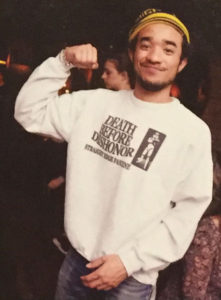 LUCIEN SMITH
LUCIEN SMITH
While still a painting student at Cooper Union, Smith, 25, racked up a number of obscure local group shows as well as an appearance with OHWOW gallery of Los Angeles in 2010 at the It Ain't Fair in Miami. Those early exposures, plus a solo bear witness debut, "Needle in the Hay" at London'southward Ritter-Zamet the following year—comprising a large-scale, semi-demolished football goalpost inspired past David Hammons's "College Goals" and early on experiments with a paint-filled fire extinguisher—drew considerable attention before long later he graduated.
But it was Smith's breakout series of seven burn down-extinguisher "pelting" paintings, with their cleverly layered allusions to Yves Klein and Abstruse Expressionism, shown at OHWOW in 2012, that started the art market wheels spinning. In June 2013, the solo-show train moved to Nib Brady Gallery in Kansas Metropolis. By so, says Brady, a transplanted New York dealer formerly of ATM Gallery, "nosotros knew people were taking a look at Lucien, but then really realized, all of a sudden, people all over the world were contacting us and buying his work." At the time, early versions of Smith'south camouflage paintings executed with stencils were priced at $24,000 for an 8-by-eleven-foot sheet That September, a two-venue exhibition, "Nature Is My Church building," alighted at Jeanne Greenberg Rohatyn's Salon 94 in New York.
The artist'southward auction initiation came just after, in November 2013, when his Winnie the Pooh–inspired Hobbes, The Rain Man, and My Friend Barney/Nether the Sycamore Tree, 2011, fetched $389,000 at Phillips. The post-obit Feb in London, Feet in the H2o, 2012, a pale-blueish pelting painting in acrylic on unprimed canvass, bearing an
OHWOW provenance, sold to a telephone bidder at Phillips for £194,500 ($319,000), far above its estimate of £xl,000 to £60,000 ($65,600-98,400). That same week at Sotheby'due south, Two Sides of the Aforementioned Coin, a 96-by-72-inch spattered rain painting in acrylic on unprimed canvas, also from 2.012, notched £224,500 ($369,000) against the aforementioned estimate.
The Smith star appeared to dim this past May at Phillips New York, when a larger-format pelting painting, Double Date, 2011, topped out at $137,000 (est. Sr oo–r 50,000). That same evening, the creative person's solo debut at Skarstedt Gallery uptown opened with is cover-up-manner abstrac-tions from his new "Tigris" series priced between $fifty,000 and $8o,000. Skarstedt notes these were "very time-consuming to produce, and information technology was a modest series, fewer than 30 paintings, which was very important to me and to him."

Lucien Smith's solo prove from 2013 called "Chip Metal" at Bill Brady Gallery
The impression of marketplace fatigue for Smith's work was reinforced when Boys Don't Cry, some other 2012 rain painting, appeared at Phillips London final July and sold for £116,500 ($zoo,000) on an approximate of £4o,000 to 6o,000 ($68,000-103,000). The toll looked relatively tame despite almost doubling the high guess—which is exactly the kind of danger young artists face up when their market cools from red-hot to plain sizzling. "I've warned whatsoever number of younger artists non to exist in too much of a bustle to be discovered," says curator Bob Nickas. "Besides cutting short those essential years of development, information technology's like being in a rush to be forgotten."
Smith himself sounded battle weary during an inter-view in August on OHWOW 's Know-Moving ridge radio. "I was a fucking poster male child for it," he said, referring to his part in what he called "the flip generation." "Every gallery is like a brothel," connected the artist. "You have, like, new talent come in and rearrange the space, but information technology all looks the same: Watch me pour bleach and, like, pee on this with flowers in it and sell it for ten g and take Niels Kantor resell it for 5o…It's crazy, butyou could purchase a work of mine today for $8o,000 and sell ittomorrow for $350,000 through an auction." He ended, "If I always make art again, I'm going to sell it at auction. I'm going to get the well-nigh corporeality of money I can for this object. David Hammons did information technology, and and then tin can I."
SANDRO CHIA
For a historical case of how runaway early success can affect an creative person's market for a lifetime—and a reminder that nosotros have been here before—i need simply look equally far every bit Chia in the early 1980s. Role of the vaunted "Iii Cs"—the Italian "Transavanguardia" artists championed past critic Achille Bonito Oliva that too included Francesco Clemente and Enzo Cucchi—Chia couldn't have been in a more enviable position. Andy Warhol did his portrait in 1980, when Chia was in his early 3os, the aforementioned year he debuted at the Venice Biennale. Between 1983 and 1984, Chia had exhibitions at the Stedelijk Museum in Amsterdam, the Metropolitan Museum of Art in New York, the Nationalgalerie of Berlin, and the Musee d'Art Moderne de la Ville de Paris.
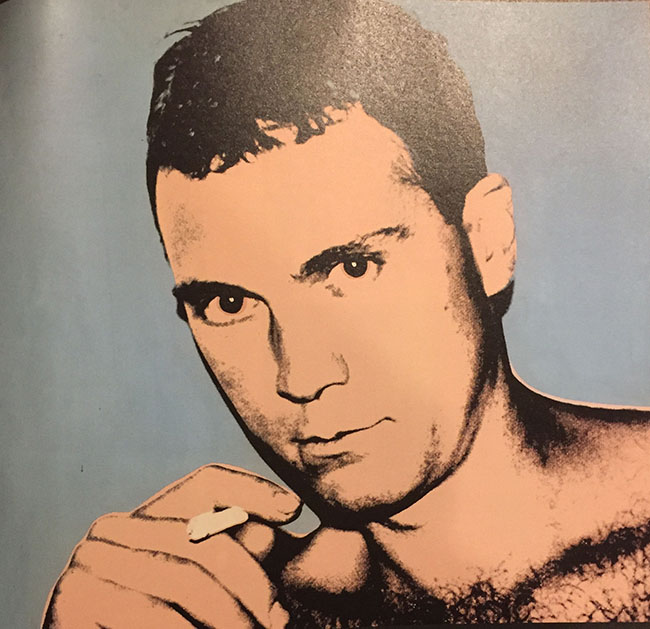
Andy Warhol'due south Untitled (Sandro Chia), 1980, hit the block at Sotheby's last month with an estimate of $134,000 to $199,00.
Past then Charles Saatchi, who would go on to virtually create a marketplace past his assembly of a drove of works by the artists who came to exist known equally YBAS, had accumulated 7 of Chia'due south figurative paintings. But in 1984, Saatchi of a sudden liquidated them on the secondary market, and the publicized dispersal sent Chia's star tumbling. Equally recounted in Kevin Goldman's Conflicting Accounts: Creation and Crash of the Saatchi & Saatchi Advertising Empire, Chia became incensed and sent Saatchi a telegram denouncing him equally a negative influence on the art world. As Chia described that episode and impact to Anthony Haden-Guest in an Baronial 1988 Vanity Fair commodity, "I thought I might every bit well go paint in Alaska. My telephone was ringing constantly and from that moment on, no 1 was ringing anymore. It was unbelievable, like you see in the movies."
Although i needn't worry overmuch near Chia'due south fortunes—he divides his time between Miami, Rome, and his vineyard estate in Montalcino, and he had a recent evidence of small watercolors at New York'southward Steven Harvey Fine Art Projects—his story is one to consider against today'southward frothier and faster market, where prices slide from 4 to six figures and back in a heartbeat. Chia has racked upwardly more than two,000 auction results, but just a half-dozen have surpassed the $200,000 mark, most recently The Crocodile's Wisdom, 1982, which made €218,800 ($336,000) at Finarte in Milan in March 2008.
Reached at his abode in Italia, Chia offered several observations about the state of the market, so and now. "In a sense, the generation of the 198os created this art state of affairs of the present," he said. "In the '80s, all this was invented from nothing—the creative person, the painter, as popular as a rock star." Asked what it felt similar to experience that fame, and if he had whatever communication for the current immature guns, Chia said, "In my case, I thought I was invulnerable. I was extremely arrogant and believed I could win any fight. What I would tell a young person would be to enjoy the success as long as it exists, considering it can't last forever."
Source: https://juddtully.net/articles/young-guns/
0 Response to "Hamster Nest Dash Snow Art in the Late 1990s Early 2000s"
Post a Comment